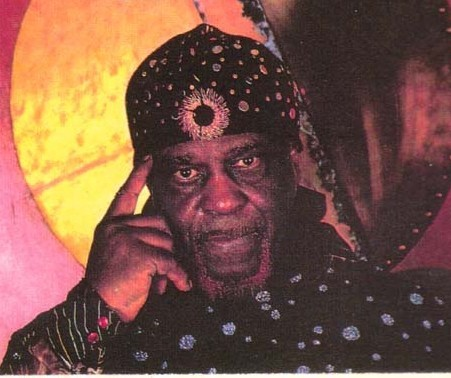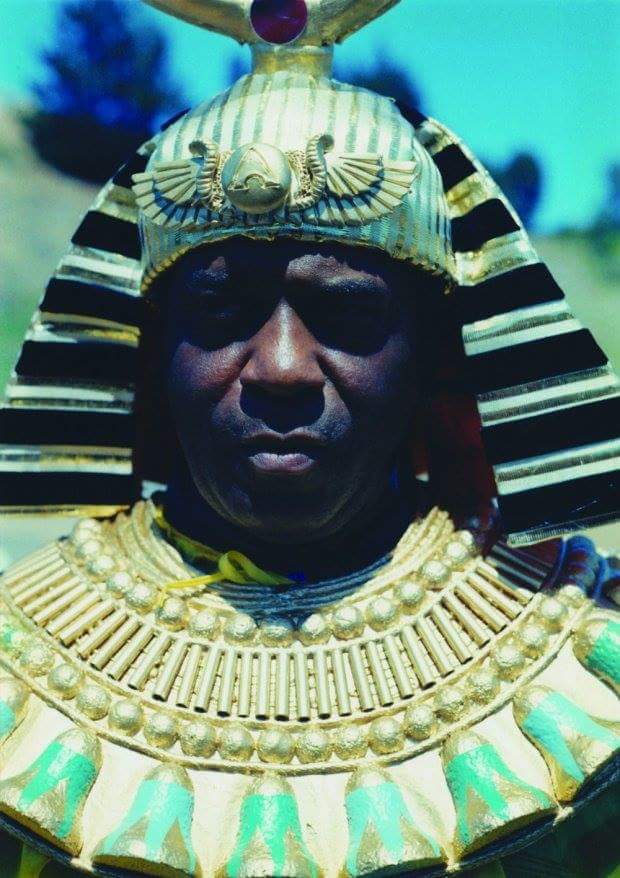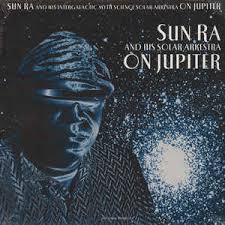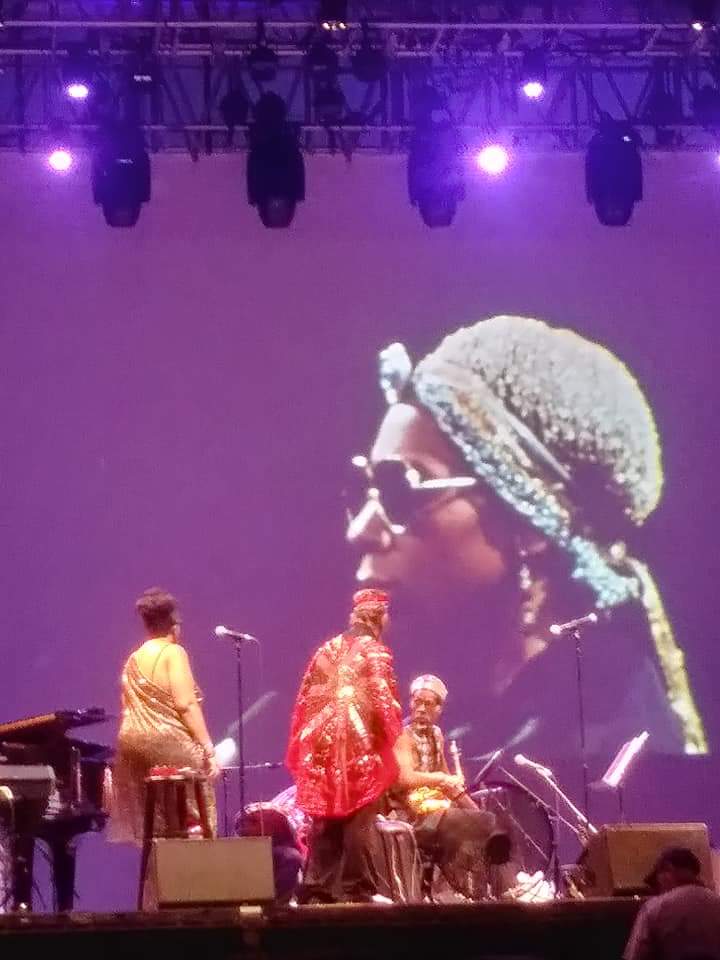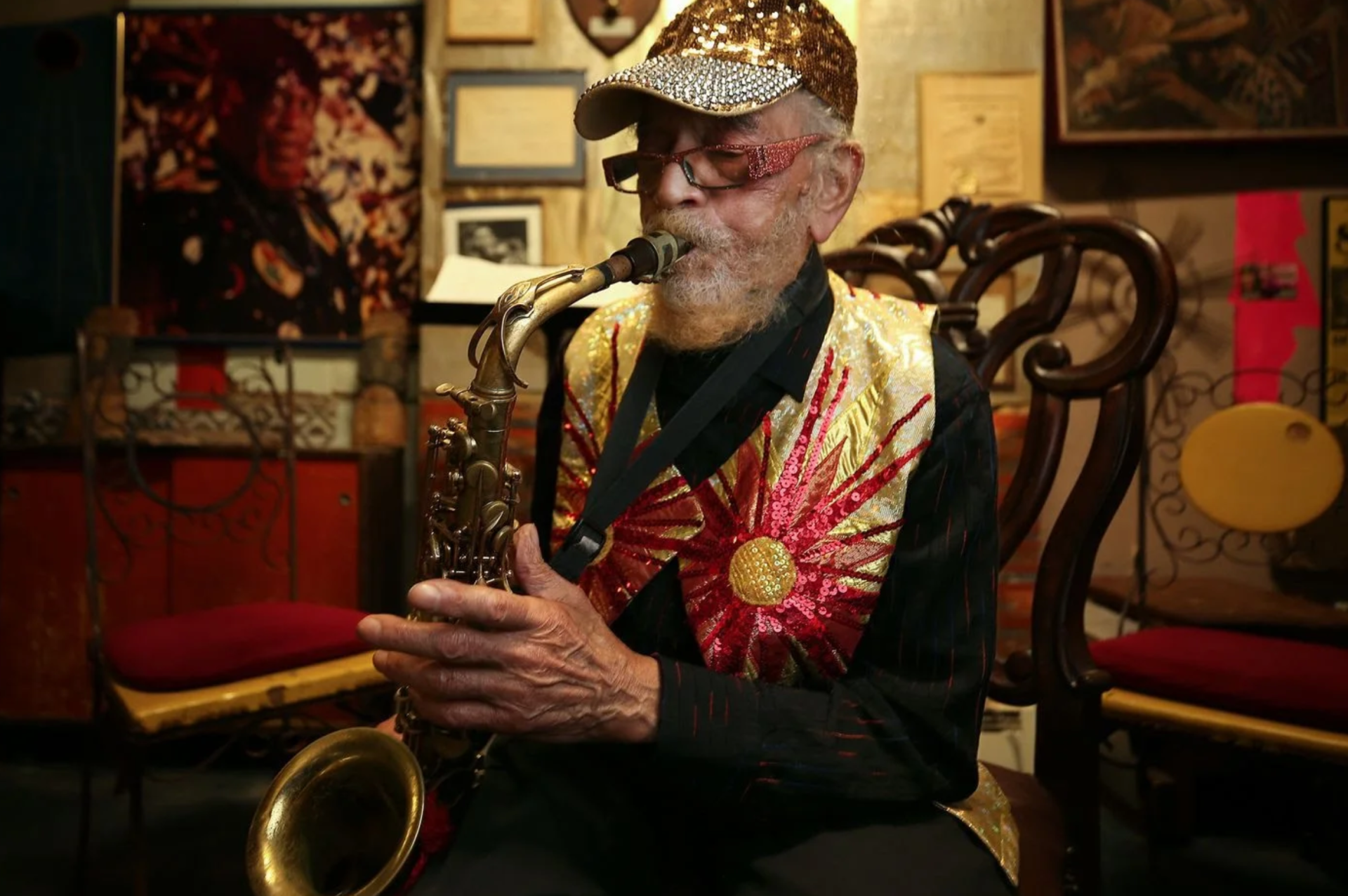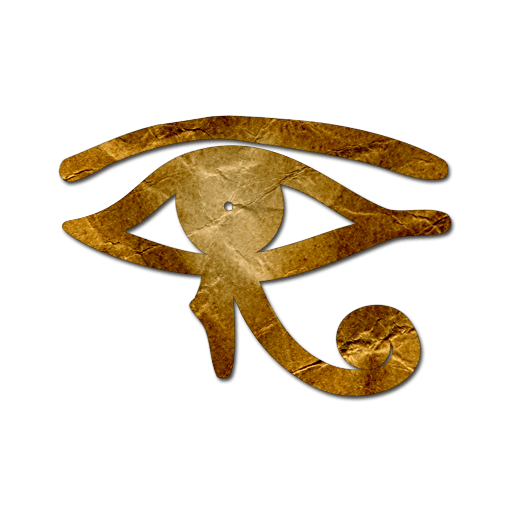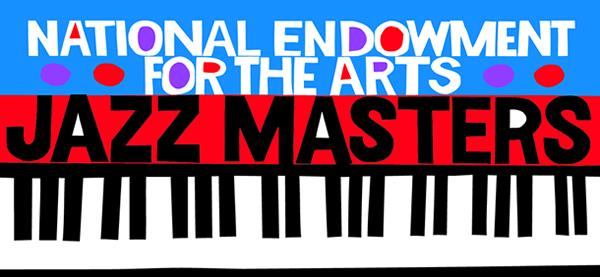
Sun Ra Appreciation Society is in the works for nominating Marshall Allen for the NEA Jazz Masters Fellowship.
This is an open call for all the musicians, journalists, producers, academics, anyone in the music industry who also believes that Marshall Allen should be honored for his lifelong dedication to jazz as a leader, educator, an artist & much more. To support this nomination by signing on to the letter below, please click on the
link here & kindly fill in the form.
SUN RA Word, Wisdom and Works
New ParagraphSun Ra Arkestra is now traveling the spaceways with their first studio album in decades.
We caught up with them at home in Philly.
Marshall Allen is sitting on the stoop of the Pharaoh’s Den, the Germantown rowhouse that’s been band headquarters of the Sun Ra Arkestra since 1968.
Resplendent in a red-and-gold vest, the bearded 96-year-old Arkestra leader is seated beside his righthand man, fellow alto sax player Knoel Scott, who’s outfitted in purple and gold, puffing on a cigarette.
The two are sitting for a sunny afternoon Zoom interview on the auspicious occasion of the release of Swirling (Strut *** 1/2), the first new Sun Ra Arkestra studio album in over 20 years.
Since 1995, Allen has led the band that’s dedicated to the music and vision of the late Herman “Sonny” Blount (1914-1993), the Afro-Futurist composer who renamed himself Sun Ra after visiting Saturn in an interplanetary vision.
In addition to sax, the irrepressibly energetic avant-garde jazzman Allen plays flute, oboe, and an electronic wind instrument called an EVI.
List of Services
-
NIDHAMUList Item 1
'Nidhamu' (The Outer Bridge)
In the half-between world
Dwell they the tone-scientists
Sound
Mathematically precise
They speak of many things
The sound-scientists
Architects of planes of discipline.
......Sun Ra (poem on Back Cover)
Alto Saxophone, Congas – Larry Northington
Alto Saxophone, Flute – Danny Davis, Hakim Rahim
Alto Saxophone, Flute, Oboe – Marshall Allen
Baritone Saxophone – Pat Patrick
Baritone Saxophone, Flute – Danny Thompson*
Bass Clarinet – Elo Omoe*
Composed By, Arranged By, Piano, Organ, Synthesizer [Moog, Rockichord] – Sun Ra
Engineer [Recording Engineer] – Tam Fiofori
Percussion – Lex Humphries, Tommy Hunter
Photography [Liner Photo] – Mike Evans*
Photography By – Sam Bankhead
Producer – Ihnfinity Inc. And The East*
Tenor Saxophone, Percussion – John Gilmore
Trumpet, Congas – Kwame Hadi
Vocals – June Tyson
-
Rare Interview With SUN RAList Item 2
Interview with Sun Ra
Francis Davis conducts a recorded interview with Sun Ra in Germantown, Philadelphia in 1990
Slought is pleased to announce a series of recordings from 1990 of Sun Ra in conversation with Jazz critic Francis Davis, released online in conjunction with "Sun Ra Meets Napoleon," an exhibition on display at Slought from November 20, 2004-January 31, 2005.
On Monday, January 29, 1990, jazz critic Francis Davis interviewed Sun Ra at the Sun Ra house on Morton Street in the Germantown section of Philadelphia. Davis recalls that while several resident Arkestra members were present, the mailman arrived at the door at almost the exact moment that he did, handed him the mail without knowing who he was, and said "good luck." One item in the mail that day was an Ed McMahon millionaire sweepstakes letter, addressed to Arkestra saxophonist John Gilmore. "JOHN GILMORE MAY ALREADY BE A WINNER," it read, and the Arkestra made quite a deal about that--as if it were an omen of some sort. Subsequent to Davis' visit, Sun Ra performed at the Philadelphia's African American Museum, and City Council honored him with a miniature Liberty Bell generally given to visiting celebrities and dignataries.
-
THE PHILOSOPHY BEHIND THE MUSIC OF SUN RAList Item 3
In the definitive biography of Sun Ra Space is the Place: The lives and times of Sun Ra, biographer John Szwed asks, “What is the legacy of a musician who thrived on paradox and mystery, and made contradiction an art form?” What often happens with Sun Ra and his legacy is that people either project what they want onto him or they misunderstand him completely. Until recently most of his writings have not been widely available so much of the philosophy behind the music has been mired in obscurity. With the recent publications of Sun Ra’s poetry, the Immeasurable Equation as well as the trio of books published by Whitewalls including The Wisdom of Sun Ra. It is easier to now historically place Sun Ra within the larger context of African American thinkers.
Sun Ra draws from so many different sources and makes so many thought-provoking conclusions it is often hard to keep up. He used sound, the written word, theatre, and film to get across a consistent vision. It is all done with a very specific and focused intent. When you look at the entirety of Sun Ra’s works across the different mediums you see a unified pattern of themes and messages. Below I’ve compiled quotes from Sun Ra and critics that shed some light on his unique philosophy.
In Szwed’s biography Space is the Place: The lives and times of Sun Ra, he explains why there is such difficulty in understanding Sun Ra’s philosophy:
Sometimes these interviews and semipublic lectures were published with ideas abruptly introduced without context, or left hanging and undeveloped. In part this was Sun Ra’s style: his ideas were almost never complete, parts of them were dropped in one conversation to be continued in an interview the same night, or another night, with another interviewer. The meaning might only become obvious after hearing ten or twenty lectures, or after reading thirty interviews. In any case, he detested completeness—things which were complete were “finished,” “ended,” dead. But in large part the difficulty in understanding Sun Ra was the result of him being edited and abbreviated, inaccurately transcribed or poorly translated (345 Szwed).
Sun Ra always took a very Afrocentric approach that was common among Black Muslims at the time. In The Wisdom of Sun Ra, Arkestra saxophonist John Gilmore explains:
At the time when I got introduced to his wisdom, he was printing his philosophy on these papers, a lot of which Black Muslims embraced. They embraced a lot of his philosophy and started putting it in their newspapers as their own thing. He and I would always hang out and they would always be questioning Sun Ra. They used to love to talk with him because he would always tell them the opposite of what they would be expecting to be told. They loved to talk with Sun Ra…That’s how they got some of their philosophy because he would share things with them. For instance, he told them that Negro meant “dead body” and it came from a word “necromancy.” He told them about interchangeable G’s and C’s and other grammar, that’s when they started giving themselves X’s. But they were filtering information from some of Sun Ra’s papers too. Coltrane was influenced by his papers. Sun used to print up these papers and give them out to people who were interested in expanding their scope of how they’d been looking at things. Before Sun Ra, they didn’t know anything about the type of stuff he was talking about. He researched and found about this stuff by himself and nobody was familiar with what he was talking about but he just spread it out and that’s how Trane got hold of some of it. Pat Patrick let him have a few papers and a few records. Reading Sun Ra’s philosophy and listening to the music opened up his mind (5 Ra, Corbett).
The interchangeable G’s and C’s is illustrated in one of the recently published broadsheets that Gilmore spoke of above:
Jesus said let the Negro bury the Negro at least that is what he said in the original Greek version of the New Testament. But according to genesis C and G are interchangeable and for this reason the words of Jesus also reads, “let the Negro bury the necro.” In the present day language, the sentence just quoted reads: “let the dead bury the dead.” The original Greek and ancient Hebrew definition of Negro or Necro is dead body. Many people think that Negro means black but if it really meant black only black people could be called Negro…Unfortunately for the Negro the word Negro means dead body…The cemetery itself is named after the word Negro: Necropolis or city of the dead. The word Niger is a Latin word meaning Black and Simon the Apostle upon whom the church was built was called Niger because he was a black man (66 Ra, Corbett).
In a lot of these writings he is riffing on derogatory names for African Americans finding hidden meanings or solutions to equations, as he would call it by making word plays.
Stop. Look! Listen! What people on earth call themselves spooks? In what country do the spooks dwel? In what country do the spooks dwel?...In America of course…...Outside of America there are no people called spooks….The spooks are in America…No other black or brown race call themselves spooks the spooks in America are different from any other race on this planet. Individual self….they hate the thought of being what they are…They want to be white rather than the black and brown that God made them. They are completely off course….They are without wisdom or understanding….they are the perfect prototype of Babylon…the Babylon that God destroyed…They are the ruined city of tophet……They are the mystery..Babylon the great whore, mother of whores……(72 Ra, Corbett).
His philosophy of a lost black history is further explained in the following passage:
……..There are two ethiopias……………………….
The American Negro is not an original inhabitant of America. The American Negro is likewise not an original inhabitant of Africa…the secret of the racial origin of the Negro is in Asia; his early history begins there. Two places hold the keys to the identity of the American Negro: Egypt and India. The first Ethiopia was in India. India was a civilization before Egypt. What we call civilization started in Asia. Asia is in the east therefore we call the Ethiopians of India “Eastern Ethiopians.” The Eastern Ethiopians migrated to the vicinity of Egypt…they are the true founders of Egypt, they are known as “the mighty builders.” They were considered as the wisest of men, and were called “the blameless Ethiops…(81 Ra, Corbett).
In a recent book The Astro Black and Other Myths, critics and fans wrote essays trying to understand and place the legacy of Sun Ra in a coherent context. The artist Kerry James Marshall writes:
So why did “Sonny” Blount choose the Egyptian style instead of the traditional Baptist, Christian model? I believe Sun Ra was inspired by early Afro-centric teachings promoted by Elijah Mohammed, through the Nation of Islam, and self-taught historians like J.A Rogers. The miseducation of the Negro by Carter G. Woodson, creator of Negro History Week and stolen Legacy by G.M. James were also highly influential in the emerging field of Afro-American studies. The “Black” man was the original man. They said, “Egyptian civilization,” which European historians managed to de-link from the “Mother Continent” was a black, African, civilization. For a people desperate to recover a sense of dignity, this is pretty great stuff (59 Corbett, Elms).
Graham Locke the author of the book Blutopia, goes even further in his essay in, The Astro Black and Other Myths book finding striking similarities of the idea Space is the Place and an old text from the 19th century.
The film Space is the Place opens with a scene in which Sun Ra inspects a distant planet to check its suitability for habitation by black people from Earth. The reference here is to Martin Delany, a pioneer of black nationalism, who, in 1859, led an expedition to the Niger Valley to find locations in which African Americans would be able to settle. Delany’s report of that expedition was republished in 1969 under the title The Search for a Place, filmed in 1972, answers directly, a point underlined by the fact that the film’s title first appears onscreen immediately after Ra has approved for black settlement the planet he’s been inspecting (33 Corbett, Elms).
That could in fact be the origins of the idea Space is the Place but Sun Ra made it clear later in his career that the idea of space was a universal and open-ended idea and not confined to the issue of race. In the John Szwed biography Space is the Place The lives and times of Sun Ra, Szwed quotes Sun Ra talking about space:
When I say space music, I’m dealing with the void, because that is of space too; but I’m dealing with the outer void, because somehow man is trapped in playing roles into the haven or heaven of the inner void, but I am not in that. That particular aim/goal does not interest my spirit-mind and because of that it moves out to something else where the word space is the synonym for a multi-dimension of different things other than what people might at present think it means. So I leave the word space open, like space is supposed to be, when I say space-music (384 Szwed).
Blacks thought I was talking about whites.
But I was Talking about everybody (382 Szwed).
Bibliography
Corbett, John, Anthony Elms, and Terri Kapsalis. Sun-Ra: Traveling the Spaceways : The Astro Black and Other Solar Myths. New York, NY: WhiteWalls, 2010. Print.
Sun, Ra, and John Corbett. The Wisdom of Sun-Ra: Sun Ra's Polemical Broadsheets and Streetcorner Leaflets. Chicago, Il.: WhiteWalls, 2006. Print.
Szwed, John F. Space Is the Place: The Lives and times of Sun Ra. New York: Da Capo, 1998. Print.
-
SPACE IS THE PLACE "The Movie"List Item 4
Composer and multidisciplinary icon Sun Ra wrote and stars in this Afrofuturist sci-fi film, featuring a killer free jazz soundtrack performed on camera by his Arkestra. Ra’s tripped out philosophy - a visionary entanglement of outer space, egyptian mythology, and world peace - is on full display, as the film explores Ra’s “origin story”; an alleged trip to Saturn he undertook in the 1930’s, a time when most other jazz musicians were still dancing the jitterbug. The stark coolness of this legendary mind warp is matched only by the rareness of Sun Ra’s Arkestra performing live in Los Angeles













